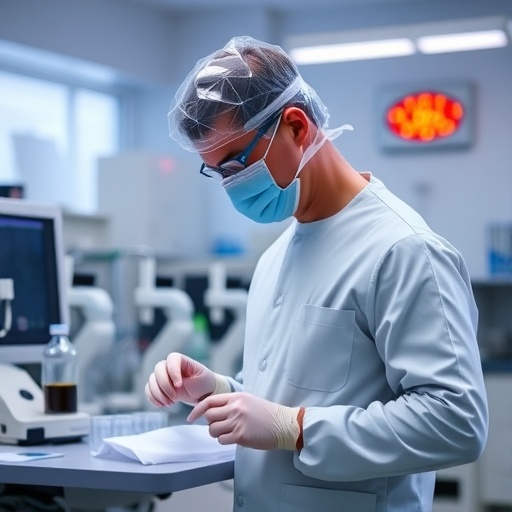In the evolving landscape of regenerative medicine, novel approaches are emerging to tackle degenerative muscle diseases, notably Duchenne muscular dystrophy (DMD), which continues to challenge the scientific community due to its severity and lack of effective long-term treatments. Breaking new ground, researchers at Sanford Burnham Prebys Medical Discovery Institute have unveiled a promising strategy that significantly enhances both the quantity and maturity of skeletal muscle progenitor cells derived from human pluripotent stem cells. This advancement, published in Stem Cell Reports on October 30, 2025, couches its significance within the broader narrative of combating muscle degeneration through refined cell therapy techniques.
Muscle wasting in degenerative diseases such as DMD results from a fundamental deficiency of dystrophin, a critical structural protein required to maintain muscle integrity during contraction and physical exertion. This absence precipitates relentless tissue damage and hampers the organ’s intrinsic capacity for repair and renewal. Historically, one of regenerative medicine’s major obstacles has been the generation of an ample supply of myogenic progenitor cells that can integrate effectively and restore damaged muscle tissue. Previous protocols often culminated in underwhelming yields and immature cells with limited therapeutic potential, stalling progress towards scalable clinical applications.
The new methodology pivots on targeted modulation of the Janus kinase 2 (JAK2) pathway, a critical signaling cascade involved in cellular growth and differentiation. Building on prior observations that transient inhibition of JAK2 fosters progenitor cell expansion in animal models, the team sophisticatedly translated these findings into human embryonic stem cells and induced pluripotent stem cells (iPSCs) derived from patients afflicted with Duchenne muscular dystrophy. This precise manipulation culminated in a twofold increase in progenitor cell yield alongside a notable shift in their developmental stage, transitioning them from an embryonic-like phenotype towards a more advanced late fetal or neonatal maturity.
Such maturation is pivotal: immature cells often lack the functional capabilities necessary for effective tissue integration and repair post-transplantation. By guiding these progenitors towards a developmentally appropriate state, the researchers mitigate the conventional limitations posed by fetal-like myocytes, which historically have demonstrated suboptimal efficacy in regenerating damaged adult musculature. The harvested cells, once transplanted into murine models, exhibited robust functional integration, rapidly contributing to muscle repair and underscoring the translational potential of this approach.
The crux of this innovation lies in undermining the JAK2-STAT3 signaling axis — a canonical pathway mediating responses to cytokines and growth factors. Inhibition of this pathway appears to unlock a previously unappreciated proliferative capacity in muscle progenitor cells, while simultaneously propelling their differentiation trajectory. This finding not only demystifies part of the molecular underpinnings governing muscle progenitor behavior but also opens new avenues for pharmacologic or genetic interventions aimed at enhancing cell-based therapies.
From a clinical perspective, these findings bear profound implications. Increasing the potency and yield of progenitor muscle cells means fewer cells are needed to achieve therapeutic benefit, thereby reducing the burdens of cell production and potentially lowering costs associated with regenerative treatments. This optimization is crucial, especially for widespread diseases like muscular dystrophies, where the scale of cellular therapy required is daunting.
Moreover, the study refines our understanding of the delicate balance between quiescence, proliferation, and differentiation in muscle stem cell biology. By temporally modulating signaling mechanisms, scientists can better harness the intrinsic regenerative qualities resident within stem cell populations, crafting therapies that could extend beyond muscular dystrophies to other degenerative conditions affecting muscle tissue.
The investigation’s rigorous experimental design employed both human iPSCs and embryonic stem cells, ensuring broad applicability and relevance to human pathology. Through this dual-system approach, the researchers demonstrated that the beneficial effects of JAK2 inhibition are not restricted to a single stem cell type, which bolsters the versatility of their protocol for future translational research.
While the promise is undeniable, the research team is candid about the necessity for further studies. Safety, efficacy, and delivery mechanisms of these enhanced muscle progenitor cells must be thoroughly evaluated in clinical contexts. Notably, recent clinical trials are exploring local injection strategies to optimize cell engraftment and minimize systemic adverse effects — a critical step towards bringing these therapies from bench to bedside.
In line with this, ongoing efforts are focused on refining the molecular inhibitors of JAK2 to improve the precision and reproducibility of progenitor cell expansion while preventing unintended consequences on other cellular pathways. Additionally, further elucidation of the molecular cues that drive the maturation process could unlock new biomarkers for assessing progenitor cell readiness and function.
This research exemplifies how targeted manipulation of intracellular signaling can resolve longstanding bottlenecks in cell generation and maturation for regenerative medicine. Beyond muscular dystrophies, the principles delineated here may be extrapolated to other degenerative diseases characterized by cellular deficit and impaired tissue regeneration, broadening the potential impact of these findings across multiple domains of health and disease.
As therapeutic paradigms advance, the integration of molecular biology insights with stem cell technology heralds an era where regenerative medicine may transition from experimental to mainstream clinical practice, offering renewed hope to patients suffering from currently intractable muscle degeneration.
Subject of Research: Animals
Article Title: Modulation of the JAK2-STAT3 pathway promotes expansion and maturation of human iPSCs-derived myogenic progenitor cells
News Publication Date: 30-Oct-2025
Web References: http://dx.doi.org/10.1016/j.stemcr.2025.102692
Image Credits: Lale Cecchini, Sacco lab, Sanford Burnham Prebys
Keywords: Muscles, Muscle cells, Muscle diseases, Muscle damage, Stem cells, Induced pluripotent stem cells, Dystrophy, Muscular dystrophy, Stem cell therapy, Regenerative medicine




